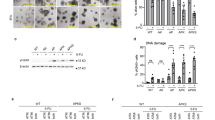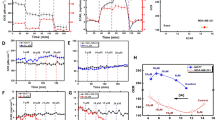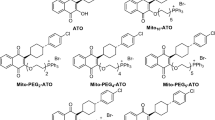Abstract
Cancer cells undergo a metabolic transformation that allows for increased anabolic demands, wherein glycolytic and tricarboxylic acid (TCA) cycle intermediates are shunted away for the synthesis of biological molecules required for cell growth and division. One of the key shunts is the exit of citrate from the mitochondria and the TCA cycle for the generation of cytosolic acetyl-coenzyme A that can be used for fatty acid and cholesterol biosynthesis. With the loss of mitochondrial citrate, cancer cells rely on the ‘conditionally essential’ amino acid glutamine (Q) as an anaplerotic carbon source for TCA cycle intermediates. Although Q deprivation causes G1 cell cycle arrest in non-transformed cells, its impact on the cancer cell cycle is not well characterized. We report here a correlation between bypass of the Q-dependent G1 checkpoint and cancer cells harboring K-Ras mutations. Instead of arresting in G1 in response to Q-deprivation, K-Ras-driven cancer cells arrest in either S- or G2/M-phase. Inhibition of K-Ras effector pathways was able to revert cells to G1 arrest upon Q deprivation. Blocking anaplerotic utilization of Q mimicked Q deprivation—causing S- and G2/M-phase arrest in K-Ras mutant cancer cells. Significantly, Q deprivation or suppression of anaplerotic Q utilization created synthetic lethality to the cell cycle phase-specific cytotoxic drugs, capecitabine and paclitaxel. These data suggest that disabling of the G1 Q checkpoint could represent a novel vulnerability of cancer cells harboring K-Ras and possibly other mutations that disable the Q-dependent checkpoint.
This is a preview of subscription content, access via your institution
Access options
Subscribe to this journal
Receive 50 print issues and online access
$259.00 per year
only $5.18 per issue
Buy this article
- Purchase on Springer Link
- Instant access to full article PDF
Prices may be subject to local taxes which are calculated during checkout




Similar content being viewed by others
References
Hanahan D, Weinberg RA . Hallmarks of cancer: the next generation. Cell 2011; 144: 646–674.
Yeung SJ, Pan J, Lee MH . Roles of p53, MYC and HIF-1 in regulating glycolysis—the seventh hallmark of cancer. Cell Mol Life Sci 2008; 65: 3981–3999.
DeBerardinis RJ, Lum JJ, Hatzivassiliou G, Thompson CB . The biology of cancer: metabolic reprogramming fuels cell growth and proliferation. Cell Metab 2008; 7: 11–20.
DeBerardinis RJ, Mancuso A, Daikhin E, Nissim I, Yudkoff M, Wehrli S et al. Beyond aerobic glycolysis: transformed cells can engage in glutamine metabolism that exceeds the requirement for protein and nucleotide synthesis. Proc Natl Acad Sci USA 2007; 104: 19345–19350.
Warburg O, Wind F, Negelein E . The metabolism of tumors in the body. J Gen Physiol 1927; 8: 519–530.
Vander Heiden MG, Cantley LC, Thompson CB . Understanding the Warburg effect: the metabolic requirements of cell proliferation. Science 2009; 324: 1029–1033.
Wise DR, DeBerardinis RJ, Mancuso A, Sayed N, Zhang XY, Pfeiffer HK et al. Myc regulates a transcriptional program that stimulates mitochondrial glutaminolysis and leads to glutamine addiction. Proc Natl Acad Sci USA 2008; 105: 18782–18787.
Gao P, Tchernyshyov I, Chang TC, Lee YS, Kita K, Ochi T et al. c-Myc suppression of miR-23a/b enhances mitochondrial glutaminase expression and glutamine metabolism. Nature 2009; 458: 762–765.
Shanware NP, Mullen AR, DeBerardinis RJ, Abraham RT . Glutamine: pleiotropic roles in tumor growth and stress resistance. J Mol Med 2011; 89: 229–236.
DeBerardinis RJ, Cheng T . Q's next: the diverse functions of glutamine in metabolism, cell biology and cancer. Oncogene 2010; 29: 313–324.
Yuneva M, Zamboni N, Oefner P, Sachidanandam R, Lazebnik Y . Deficiency in glutamine but not glucose induces MYC-dependent apoptosis in human cells. J Cell Biol 2007; 178: 93–105.
Gaglio D, Soldati C, Vanoni M, Alberghina L, Chiaradonna F . Glutamine deprivation induces abortive S-phase rescued by deoxyribonucleotides in K-Ras transformed fibroblasts. PLoS ONE 2009; 4: e4715.
Saqcena M, Menon D, Patel D, Mukhopadhyay S, Chow V, Foster DA . Amino acids and mTOR mediate distinct metabolic checkpoints in mammalian G1 cell cycle. PLoS ONE 2013; 8: e74157.
Pardee AB . A restriction point for control of normal animal cell proliferation. Proc Natl Acad Sci USA 1974; 71: 1286–1290.
Liu P, Begley M, Michowski W, Inuzuka H, Ginzberg M, Gao D et al. Cell-cycle-regulated activation of Akt kinase by phosphorylation at its carboxyl terminus. Nature 2014; 508: 541–545.
Hahn WC, Counter CM, Lundberg AS, Beijersbergen RL, Brooks MW, Weinberg RA . Creation of human tumour cells with defined genetic elements. Nature 1999; 400: 464–468.
Hahn WC, Dessain SK, Brooks MW, King JE, Elenbaas B, Sabatini DM et al. Enumeration of the simian virus 40 early region elements necessary for human cell transformation. Mol Cell Biol 2002; 22: 2111–2123.
Foster DA, Yellen P, Xu L, Saqcena M . Regulation of G1 cell cycle progression: distinguishing the restriction point from a nutrient-sensing cell growth checkpoint(s). Genes Cancer 2010; 1: 1124–1131.
Mendoza MC, Er EE, Blenis J . The Ras-ERK and PI3K-mTOR pathways: cross-talk and compensation. Trends Biochem Sci 2011; 36: 320–328.
Kodaki T, Woscholski R, Hallberg B, Rodriguez-Viciana P, Downward J, Parker PJ . The activation of phosphatidylinositol 3-kinase by Ras. Curr Biol 1994; 4: 798–806.
Roux PP, Ballif BA, Anjum R, Gygi SP, Blenis J . Tumor-promoting phorbol esters and activated Ras inactivate the tuberous sclerosis tumor suppressor complex via p90 ribosomal S6 kinase. Proc Natl Acad Sci USA 2004; 101: 13489–13494.
Bodnar AG, Ouellette M, Frolkis M, Holt SE, Chiu CP, Morin GB et al. Extension of life-span by introduction of telomerase into normal human cells. Science 1998; 279: 349–352.
Serrano M, Lin AW, McCurrach ME, Beach D, Lowe SW . Oncogenic ras provokes premature cell senescence associated with accumulation of p53 and p16INK4a. Cell 1997; 88: 593–602.
Dotto GP, Parada LF, Weinberg RA . Specific growth response of ras-transformed embryo fibroblasts to tumour promoters. Nature 1985; 318: 472–475.
Walko CM, Lindley C . Capecitabine: a review. Clin Ther 2005; 27: 23–44.
Wahl AF, Donaldson KL, Fairchild C, Lee FY, Foster SA, Demers GW et al. Loss of normal p53 function confers sensitization to Taxol by increasing G2/M arrest and apoptosis. Nat Med 1996; 2: 72–79.
Deberardinis RJ, Sayed N, Ditsworth D, Thompson CB . Brick by brick: metabolism and tumor cell growth. Curr Opin Genet Dev 2008; 18: 54–61.
Son J, Lyssiotis CA, Ying H, Wang X, Hua S, Ligorio M et al. Glutamine supports pancreatic cancer growth through a KRAS-regulated metabolic pathway. Nature 2013; 496: 101–105.
Wise DR, Thompson CB . Glutamine addiction: a new therapeutic target in cancer. Trends Biochem Sci 2010; 35: 427–433.
Thornburg JM, Nelson KK, Clem BF, Lane AN, Arumugam S, Simmons A et al. Targeting aspartate aminotransferase in breast cancer. Breast Cancer Res 2008; 10: R84.
Ward PS, Thompson CB . Metabolic reprogramming: a cancer hallmark even warburg did not anticipate. Cancer Cell 2012; 21: 297–308.
Wang XS, Shankar S, Dhanasekaran SM, Ateeq B, Sasaki AT, Jing X et al. Characterization of KRAS rearrangements in metastatic prostate cancer. Cancer Discov 2011; 1: 35–43.
Bos JL . ras oncogenes in human cancer: a review. Cancer Res 1989; 49: 4682–4689.
Schneider G, Siveke JT, Eckel F, Schmid RM . Pancreatic cancer: basic and clinical aspects. Gastroenterology 2005; 128: 1606–1625.
Baker NM, Der CJ . Cancer: drug for an 'undruggable' protein. Nature 2013; 497: 577–578.
Kamphorst JJ, Cross JR, Fan J, de Stanchina E, Mathew R, White EP et al. Hypoxic and Ras-transformed cells support growth by scavenging unsaturated fatty acids from lysophospholipids. Proc Natl Acad Sci USA 2013; 110: 8882–8887.
Salloum D, Mukhopadhyay S, Tung K, Polonetskaya A, Foster DA . Mutant ras elevates dependence on serum lipids and creates a synthetic lethality for rapamycin. Mol Cancer Ther 2014; 13: 733–741.
Commisso C, Davidson SM, Soydaner-Azeloglu RG, Parker SJ, Kamphorst JJ, Hackett S et al. Macropinocytosis of protein is an amino acid supply route in Ras-transformed cells. Nature 2013; 497: 633–637.
Forbes SA, Bindal N, Bamford S, Cole C, Kok CY, Beare D et al. COSMIC: mining complete cancer genomes in the catalogue of somatic mutations in cancer. Nucleic Acids Res 2011; 39: D945–D950.
Barretina J, Caponigro G, Stransky N, Venkatesan K, Margolin AA, Kim S et al. The cancer cell line encyclopedia enables predictive modelling of anticancer drug sensitivity. Nature 2012; 483: 603–607.
Chen Y, Rodrik V, Foster DA . Alternative phospholipase D/mTOR survival signal in human breast cancer cells. Oncogene 2005; 24: 672–679.
Acknowledgements
This study was supported by the National Institute of Health grant R01-CA046677 and a pilot project award from the Research Centers in Minority Institutions award RP-03037 from the National Center for Research Resources of the National Institute of Health.
Author information
Authors and Affiliations
Corresponding author
Ethics declarations
Competing interests
The authors declare no conflict of interest.
Additional information
Supplementary Information accompanies this paper on the Oncogene website
Rights and permissions
About this article
Cite this article
Saqcena, M., Mukhopadhyay, S., Hosny, C. et al. Blocking anaplerotic entry of glutamine into the TCA cycle sensitizes K-Ras mutant cancer cells to cytotoxic drugs. Oncogene 34, 2672–2680 (2015). https://doi.org/10.1038/onc.2014.207
Received:
Revised:
Accepted:
Published:
Issue Date:
DOI: https://doi.org/10.1038/onc.2014.207
This article is cited by
-
SIRT4 functions as a tumor suppressor during prostate cancer by inducing apoptosis and inhibiting glutamine metabolism
Scientific Reports (2022)
-
KRAS mutation: from undruggable to druggable in cancer
Signal Transduction and Targeted Therapy (2021)
-
Glutamine reliance in cell metabolism
Experimental & Molecular Medicine (2020)
-
Role of PKM2 in directing the metabolic fate of glucose in cancer: a potential therapeutic target
Cellular Oncology (2018)
-
FR58P1a; a new uncoupler of OXPHOS that inhibits migration in triple-negative breast cancer cells via Sirt1/AMPK/β1-integrin pathway
Scientific Reports (2018)



